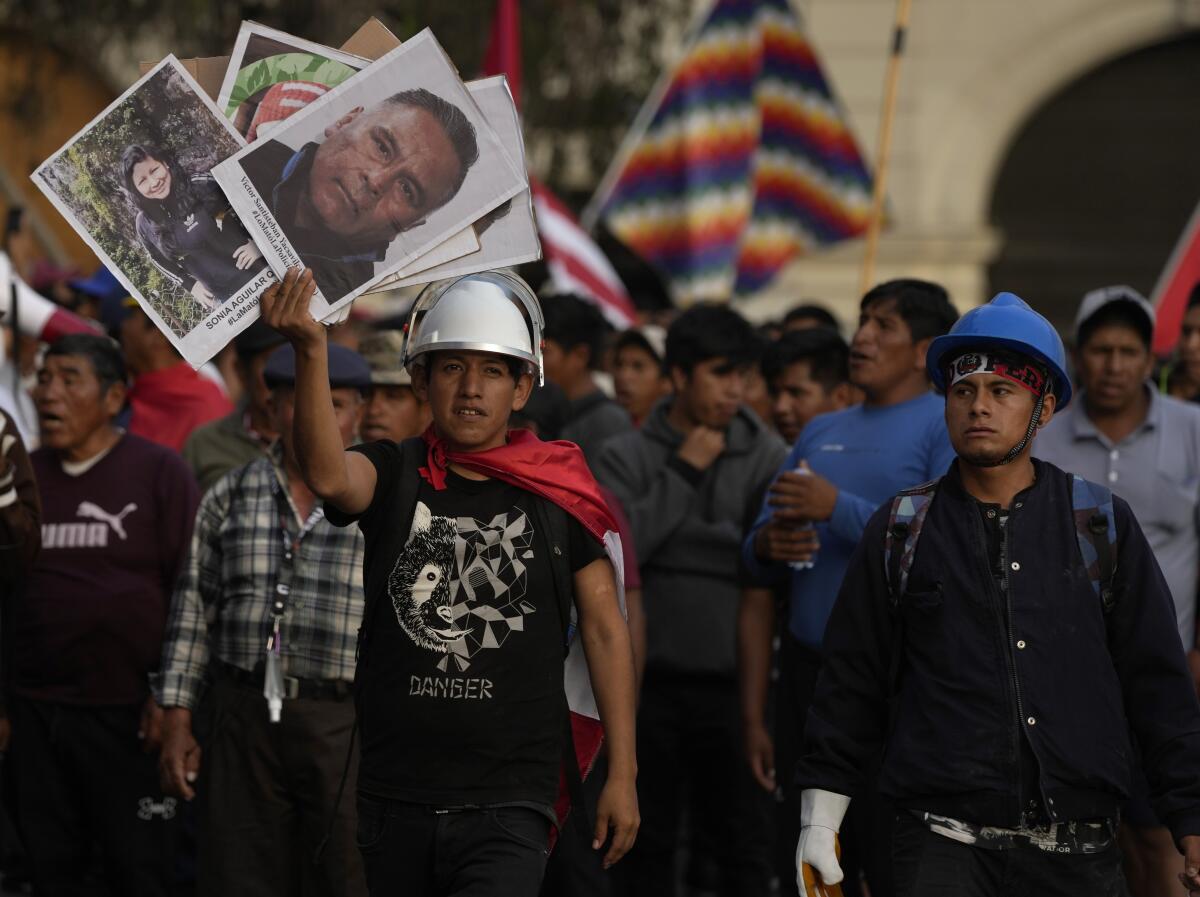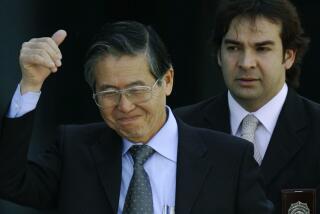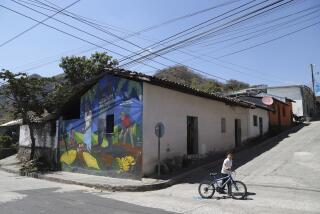As Peru descends into violent turmoil, California immigrants take sides

- Share via
In the two months since Peru’s leftist former president Pedro Castillo was arrested, driven from office and replaced by his vice-president, Dina Boluarte, protests in the South American nation have grown and spread from the Andean hinterlands to the streets of the capital, Lima.
At the same time, fissures have widened among the 720,000 U.S. residents who identify as being of Peruvian origin, including 91,511 in California, second to Florida’s 100,965.
The polarization here has mimicked Peru’s party-line divisions, pitting those who view Castillo — a former union leader and elementary school teacher who took office in July 2021 — as a champion of the working-class urban poor and the rural Indigenous, and those who regard him as a dangerous populist who tried to dissolve Congress in a coup.
“Since the president was sworn in, they didn’t let him work, they were going to overthrow him anyway,” said Jean Paul Vicharra, a native of Callao, a small city west of the capital.
Vicharra, 23, arrived in Los Angeles just 15 days after Castillo tried to dissolve Congress on Dec. 7 and rule by decree. On that same date, 101 members of Peru’s 130-member parliament voted to dismiss the president, citing his “permanent moral incapacity.”
But many of the president’s supporters, including those like Vicharra in California, assert that the way in which Castillo was removed by congress was itself an illegal coup.
“I left Peru because of the situation my country is facing, it is very complicated,” said Vicharra, who owned a printing workshop in Lima before he emigrated to the United States.
“This political and demonstration crisis affects all businesses,” he continued. “Sales began to drop a lot, now it is worse. People are going bankrupt.”
At least 58 deaths have been recorded in Peru since the protests began, raising concerns by the Organization of American States about excessive use of force by the government. The OAS asked the Boluarte administrations to call early general elections, as a way of resolving the crisis and stemming the bloodshed, an issue on which the Peruvian Congress has not reached consensus.
In Los Angeles, members of the Quechua and Aymara Indigenous peoples in the United States have held five protests since the crisis began.
“We want the repression to stop, the murders to stop, especially in the south of Peru,” said Miriam Agüero, president of the organization, which has sent letters expressing concern to several U.S. Congress members.
Among their demands, Agüero said, is the request for Boluarte to resign and for Congress to be closed.
“We are supporting a referendum for a constituent assembly, because the people have to decide,” said the activist from Arequipa, whose parents are of Quechua origin. “Castillo entered with the banner of the new constitution and that is what the people supported. The people know that the 1993 constitution is not made for the well-being of the people, but for the well-being of a privileged few.”
Since the end of a vicious civil war in the 1980s and early ‘90s between the Maoist guerrilla group Sendero Luminoso (Shining Path) and government forces, which left tens of thousands dead, Peru has struggled to establish the rule of law, raise its economy and curtail the centuries-old oppression of its Indigenous peoples.
The current Peruvian Constitution was drawn up during the mandate of President Alberto Fujimori, after he dissolved Congress and suspended the constitution during the so-called autogolpe (self-coup) of April 1992. Fujimori led the government’s scorched-earth campaign that eventually defeated Shining Path and imprisoned its fanatical leader, Abimael Guzmán, but was widely condemned for human rights abuses. The 84-year-old former president has been in prison since 2007 after being convicted of the crimes of murder and kidnapping in the Barrios Altos (1991) and La Cantuta (1992) massacres. He also was convicted of embezzlement.
Yet Fujimori remains a popular figure among Peruvians and U.S. residents who credit him with boosting the nation’s economy and restoring civil order, albeit at an exorbitant price.
“The way out [to the crisis] is early elections,” says Julio Zelaya, a Union City resident and supporter of Fuerza Popular, a party that in 2021 competed for the presidency with candidate Keiko Fujimori, daughter of the former president. Fujimori was defeated by Castillo of the Peru Libre Party.
Julio Zelaya regards Castillo and Peru Libre as radical leftists, and rejects their call for a referendum on a new constitution.
“What they want is to impose a new economic model, in the socialist style like the one in Venezuela and Cuba,” said Zelaya, a former Fuerza Popular Party candidate for one of the two posts in Peru’s Congress representing the Peruvian diaspora.
“They are not democrats,” Zelaya continued. “They think of Abimael Guzmán — he said that you have to take from the rich to give to the poor. That’s why they want a change to the constitution.”
Other Pervuvian residents of California suggest that their homeland’s problems go far beyond partisan politics.
“Castillo has done the same as Fujimori by shutting down Congress,” said Milagros Lizárraga, a Peruvian activist and community leader in Southern California, who thinks that none of Peru’s political parties, regardless of ideology, are helping the society’s most vulnerable sectors.
“There is a double standard everywhere. Every time the polarization is stronger and there is no dialogue,” Lizárraga said. “They are throwing the ball between the executive and the legislative, between the president and Congress. They are divided, seeing their interests and no one is making sacrifices, seeing the well-being of the people.”
In the absence of an agreement in Congress, Boluarte on Feb. 2 presented a proposal to legislators to advance national elections to October, meaning that current office holders would leave their posts in December 2023; the new office holders elected in October would serve until July 2026. Congress would need to approve any such plan to move up elections.
The Peruvian crisis reflects a prolonged power struggle, said Julio César Baluarte, who gave up law and political science to pursue acting in his homeland. He believes the constitution must be changed.
“We have a Constitution written by a dictator, made to satisfy personal and political whims,” said the Lima native and Palm Desert resident, who didn’t vote in the 2021 elections because he deemed no candidate worthy of being president.
“For things to flow more or less well, we have to make a profound change in our [government] system,” Baluarte stressed.
Since Fujimori’s departure in November 2000, only two presidents have finished their terms: Alejandro Toledo (2001-06) and Ollanta Humala (2011-16). Humala’s successor, Pedro Pablo Kuczynski (2016-18), resigned in the aftermath of a bribery scandal.
“They have all been corrupt,” said Miguel Tinker Salas, a professor of Latin American Studies at Pomona College. “In this case they have not been able to prove corruption against Pedro Castillo,” but Castillo’s own blunders and lack of political experience have given his enemies an opening to remove him, Tinker Salas said.
Tinker Salas said that the Peruvian right, which controls Congress, didn’t count on the ability of Indigenous people and social organizations to mobilize and bring protesters into the streets en masse.
“They have faced a Peru that they do not know,” Tinker Salas said, “the deep, Indigenous Peru, the one from the interior of the country that saw in Castillo its first ruler who represented them even with all his faults.”
More to Read
Sign up for Essential California
The most important California stories and recommendations in your inbox every morning.
You may occasionally receive promotional content from the Los Angeles Times.











